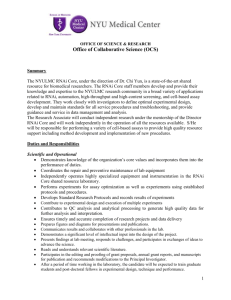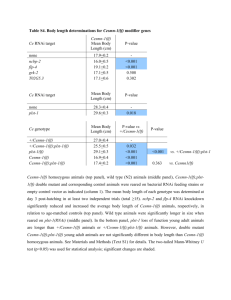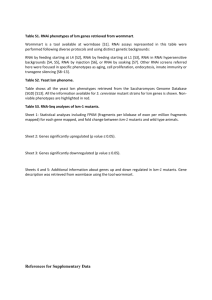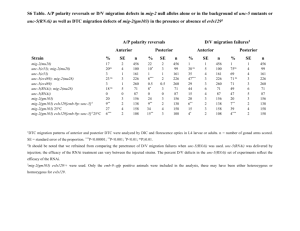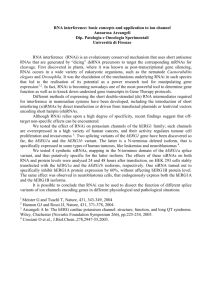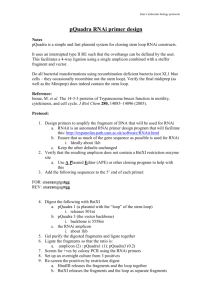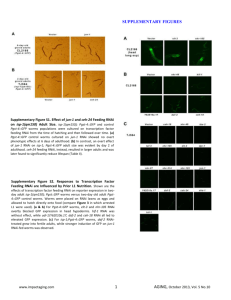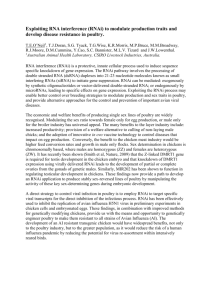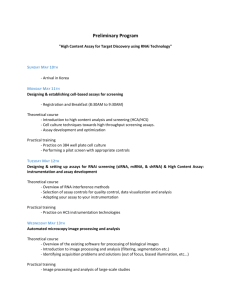Supplementary Methods - Word file (71 KB )
advertisement
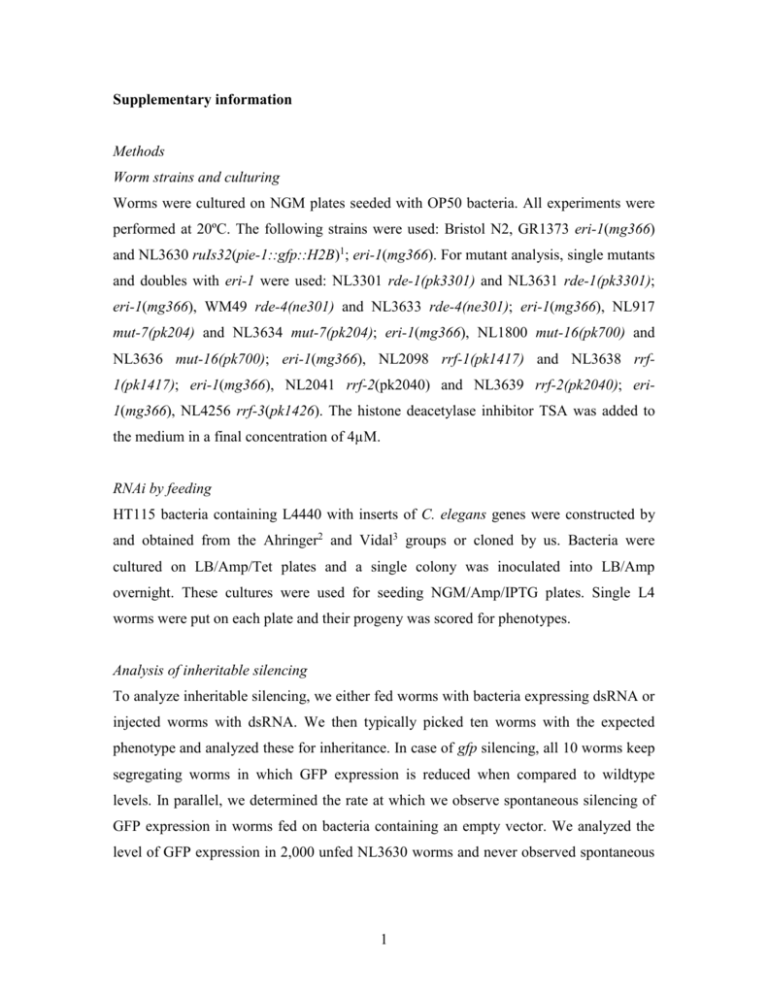
Supplementary information Methods Worm strains and culturing Worms were cultured on NGM plates seeded with OP50 bacteria. All experiments were performed at 20ºC. The following strains were used: Bristol N2, GR1373 eri-1(mg366) and NL3630 ruIs32(pie-1::gfp::H2B)1; eri-1(mg366). For mutant analysis, single mutants and doubles with eri-1 were used: NL3301 rde-1(pk3301) and NL3631 rde-1(pk3301); eri-1(mg366), WM49 rde-4(ne301) and NL3633 rde-4(ne301); eri-1(mg366), NL917 mut-7(pk204) and NL3634 mut-7(pk204); eri-1(mg366), NL1800 mut-16(pk700) and NL3636 mut-16(pk700); eri-1(mg366), NL2098 rrf-1(pk1417) and NL3638 rrf1(pk1417); eri-1(mg366), NL2041 rrf-2(pk2040) and NL3639 rrf-2(pk2040); eri1(mg366), NL4256 rrf-3(pk1426). The histone deacetylase inhibitor TSA was added to the medium in a final concentration of 4µM. RNAi by feeding HT115 bacteria containing L4440 with inserts of C. elegans genes were constructed by and obtained from the Ahringer2 and Vidal3 groups or cloned by us. Bacteria were cultured on LB/Amp/Tet plates and a single colony was inoculated into LB/Amp overnight. These cultures were used for seeding NGM/Amp/IPTG plates. Single L4 worms were put on each plate and their progeny was scored for phenotypes. Analysis of inheritable silencing To analyze inheritable silencing, we either fed worms with bacteria expressing dsRNA or injected worms with dsRNA. We then typically picked ten worms with the expected phenotype and analyzed these for inheritance. In case of gfp silencing, all 10 worms keep segregating worms in which GFP expression is reduced when compared to wildtype levels. In parallel, we determined the rate at which we observe spontaneous silencing of GFP expression in worms fed on bacteria containing an empty vector. We analyzed the level of GFP expression in 2,000 unfed NL3630 worms and never observed spontaneous 1 silencing of GFP expression. Thus, spontaneous silencing is orders of magnitude lower than the rate at which RNAi induced phenotypes are inherited. Analysis of the genetic requirements for initiation and maintenance of silencing First, we analyzed the role of genes implicated in RNAi (i.e. rde-1, rde-4, mut-7, mut-16, rrf-1, rrf-2 and rrf-3) for their role in initiation and maintenance of silencing of ceh-13 and dpy-28 (for rrf-2, maintenance of silencing was only tested for dpy-28 silencing; for rrf-3, maintenance was only tested for ceh-13). For dpy-28, we constructed doublemutant combinations containing eri-1 and each of these seven mutants listed. To identify genes that are required for maintenance of inheritable silencing, we performed an RNAi screen. We tested RNAi feeding clones for 164 genes known to be involved in RNA silencing processes by previous studies4-7, as well as candidate genes with the potential to be involved in (transcriptional) gene silencing, including C. elegans Argonauts, histone (de)acetylases and other genes implicated in chromatin remodeling: AC3.4 (pqn-2), B0035.12, B0302.5, B0336.3, B0379.3 (mut-16), B0414.7 (mtk-1), C01G5.2 (prg-2), C04F12.1, C04G4.5 (mes-6), C06A1.4, C08B11.2 (hda-2), C08F8.2, C10E2.3 (hda-4), C12D8.1, C14B1.7 (ppw-3), C14C11.6 (mut-14), C16C10.3, C18E3.2, C18E3.7, C18G1.7, C24F3.4, C26C6.1, C26F1.3, C26H9A.1 (vha-7), C27B7.4, C28A5.1, C28A5.2, C35A5.9, C37A2.7, C41G7.1 (smn-1), C50E10.4 (sop-2), C52B9.8, D2030.6 (prg-1), D2096.8, DY3.2 (lmn-1), F01G4.1 (psa-4), F02E9.4 (pqn-28), F10E9.8 (sas-4), F14H3.12, F15B10.2 (drh-1), F16D3.2 (rsd-6), F20B6.5, F20D12.1 (ppw-4), F21C3.4 (mut-8), F22D6.6, F26A3.3 (ego-1), F26H11.1, F33A8.1 (let-858), F35G12.10 (asb-1), F35H8.3, F37A4.8 (isw-1), T01C3.8 (mut-15), T04A8.14 (emb-5), T04C12.2 (srh-75), T05E8.3, T07A9.8, T07D3.7 (alg-2), T07D4.3 (rha-1), T09B4.9, T09E8.1, T12D8.1 (tag-359), T13H2.4 (pqn-65), T19B10.7 (ima-1), T19B4.5, T19C4.5, T20G5.11 (rde-4), T22B3.2, T22B7.2 (egl-13), T22D1.3, T22H9.3, T23B12.1, T23B5.3, T23D8.7, T24C4.1, T24H7.1 (phb-2), W01B11.3, W02A11.4 (uba-2), W02D9.3, W05H7.4, Y106G6H.2 (pab-1), Y110A7A.16, F37B12.4, F37C12.4 (rpl-36), F38A5.10, F39C12.2 (add-1), F43E2.1, F43G6.4, F43G9.1, F43G9.5, F45E4.10 (gfi-4), F45E4.9 (hmg-5), F48F7.1 (alg-1), F54C1.3 (mes-3), F54F2.2 (zfp-1), F54H12.1 (aco-2), F55A12.1, F55A3.3 (phi-6), F55A4.4, F55F8.3, F56A6.1, F58G1.1, H06I04.3, H19N07.2, 2 H25K10.6, K03D10.3, K04F10.6 (rde-3), K07A1.12 (lin-53), K07A12.3 (asg-1), K07C5.4, K07H8.10, K08D10.4 (rnp-2), K08F4.2, K08H10.7 (rde-1), K10D12.3, K10D2.3, K12B6.1, K12H4.8 (dcr-1), M01F1.3, M03C11.8, M03D4.6, M03F8.3, M04B2.3 (gfl-1), R03D7.4, R04A9.2, R06A4.7 (mes-2), R06C1.1 (hda-3), R06C7.1, R07E5.3, R09A1.1, R13F6.1, Y110A7A.18 (ppw-2), Y113G7B.14, Y113G7B.23 (psa1), Y12A6A.1, Y2H9A.1 (mes-4), Y37D8A.9 (mrg-1), Y38A10A.6, Y39A3CR.8, Y40B10A.6, Y43F8C.8, Y48B6A.3 (xrn-1), Y49F6A.1, Y49F6B.4 (smu-2), Y51H1A.5 (hda-6), Y54E5A.4 (npp-4), Y56A3A.17 (npp-16), Y71H2AM.23, Y77E11A.7, ZC449.3, ZK1098.8 (mut-7), ZK112.2, ZK1127.3, ZK1127.9, ZK1128.5, ZK1248.7, ZK218.8, ZK381.4 (pgl-1), ZK593.7 (lsm-7), ZK757.3 and ZK858.7. The initial screen was done in duplo: worms displaying the Dpy-6 phenotype were put on the RNAi plates and their progeny was scored for the absence of Dpy worms. In the initial screen, only four plates scored positive (i.e. no Dumpy worms were present in the progeny). This was confirmed at least in five-fold. For hda-4, K03D10.3 and mrg-1, these data are also confirmed by relieve of the maintained silencing of GFP expression. Knock-down of isw1 results in sterile progeny, making it impossible to look for re-expression of GFP in the germline. Once inheritance is relieved (either by RNAi or TSA), it does not recur when the worms are taken of the RNAi or TSA plates. This was tested for both dpy-6 and gfp inheritable silencing. Microscopy Young adults were categorized after inspection with the Zeiss M2BIO at 660x magnification. AxioVision was used for capturing images (400x) of live worms put on 2% agarose pads; the same exposure time (~400ms) was used for capturing images to be compared in the same experiment. Supplementary Table 1. Genes required for initiation or maintenance of inheritable silencing. Gene Name Allele Domain/function Initiation Inheritance Genes implicated in RNAi K08H10.7 T20G5.11 rde-1 rde-4 pk3301 ne301 PAZ/PIWI domain dsRNA binding - + + 3 ZK1098.8 mut-7 pk204 3’-5’ exonuclease domain + + B0379.3 mut-16 pk700 Glutamine/Asparagine-rich domain + + F26A3.8 rrf-1 pk1417 RdRP + + M01G12.12 F10B5.7 rrf-2 rrf-3 pk2040 pk1426 RdRP RdRP + + + + Genes with a chromatin-related function C10E2.3 hda-4 RNAi Histone Deacetylase nd - K03D10.3 - RNAi Acetyltransferase nd - F37A4.8 isw-1 RNAi Chromatin Remodeling nd - Y37D8A.9 mrg-1 RNAi Chromatin Remodeling nd - Indicated are the gene tested, its canonical name, the allele tested (or RNAi knockout), a short description of its domain or function, its requirement for initiation and its requirement for inheritance (+ not (fully) required, - dispensable). References 1. Praitis, V., Casey, E., Collar, D. & Austin, J. Creation of low-copy integrated transgenic lines in Caenorhabditis elegans. Genetics 157, 1217-26 (2001). 2. Kamath, R. S. et al. Systematic functional analysis of the Caenorhabditis elegans genome using RNAi. Nature 421, 231-7 (2003). 3. Rual, J. F. et al. Toward improving Caenorhabditis elegans phenome mapping with an ORFeome-based RNAi library. Genome Res 14, 2162-8 (2004). 4. Vastenhouw, N. L. et al. A genome-wide screen identifies 27 genes involved in transposon silencing in C. elegans. Curr Biol 13, 1311-6 (2003). 5. Kim, J. K. et al. Functional genomic analysis of RNA interference in C. elegans. Science 308, 1164-7 (2005). 6. Grishok, A., Sinskey, J. L. & Sharp, P. A. Transcriptional silencing of a transgene by RNAi in the soma of C. elegans. Genes Dev 19, 683-96 (2005). 7. Robert, V. J., Sijen, T., van Wolfswinkel, J. & Plasterk, R. H. Chromatin and RNAi factors protect the C. elegans germline against repetitive sequences. Genes Dev 19, 782-7 (2005). 4

